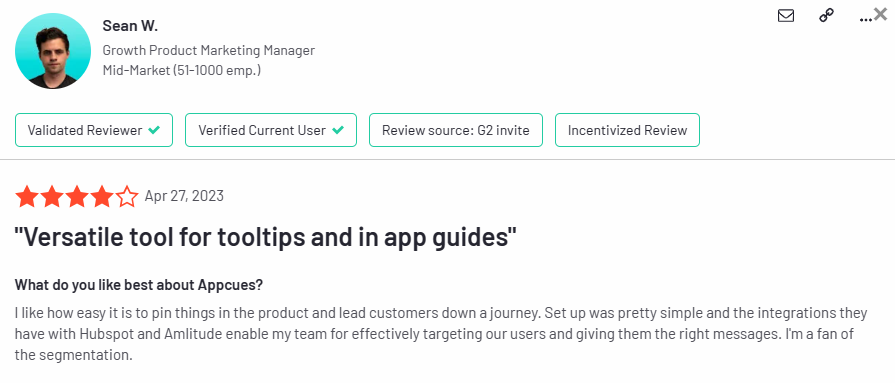Appcues for User Behavior Analysis: Features, Pricing, and Review
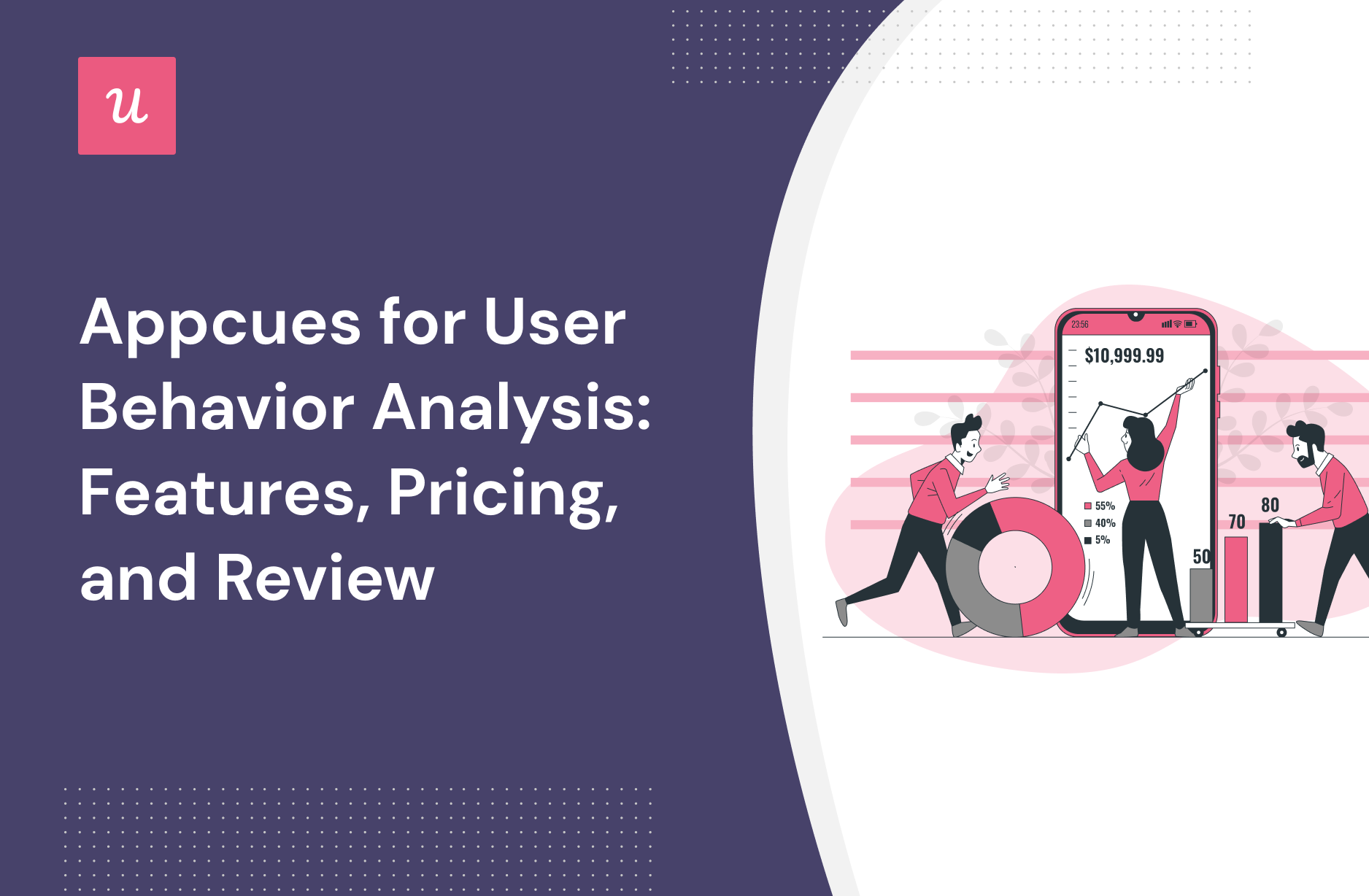
Looking for an effective user behavior analysis tool and wondering if Appcues is the best option for your SaaS company?
With numerous Appcues alternatives, it can be challenging to make a final decision.
In this article, we’ll delve into precisely that – helping you determine whether Appcues is the ideal choice for your User behavior analysis needs. We’ll explore its features, pricing, and offer a comprehensive review to aid in your decision-making process.
Let’s get started!
TL;DR
- Appcues is a good choice for User behavior analysis and it comes with features such as event tracking, feature tags, user journey mapping, and user segmentation analysis.
- Are you wondering if Appcues is the right fit for your user onboarding needs or if you should check out other options?
- Here are a few reasons why using an Appcues alternative makes sense:
- You want more customizability. Customization options on Appcues are limited to color, size, and style. Advanced customization will require you to work with CSS code. It can be a roadblock when your team members lack technical expertise, leaving you dependent on developers.
- You’re on a budget. With Appcues, you’ll have to pay more to access advanced features like custom CSS, localization or even simple checklists. If you’re a startup or small business with a limited budget, you might benefit from using a tool like Userpilot that offers more value for money.
- You want to collect detailed customer feedback. Appcues offers limited functionality in terms of surveys. If you want to explore other survey and feedback collection formats apart from NPS, Appcues may not be an ideal choice.
- If you’re looking for a better option for User behavior analysis, Userpilot exceeds both functionality and value for money compared to Appcues. Ready to see Userpilot in action? Schedule a demo today to explore its powerful User behavior analysis capabilities firsthand.
![]()
Looking for a Better Alternative for User Behavior Analysis? Try Userpilot

What is Appcues?
Appcues is a robust product adoption and user onboarding platform for web and mobile apps. It enables product teams to create, implement, and test personalized in-app onboarding experiences. The platform also helps you announce new product features and collect customer feedback.
What makes this platform even better is the fact that it offers no-code features that make it suitable for non-technical teams. 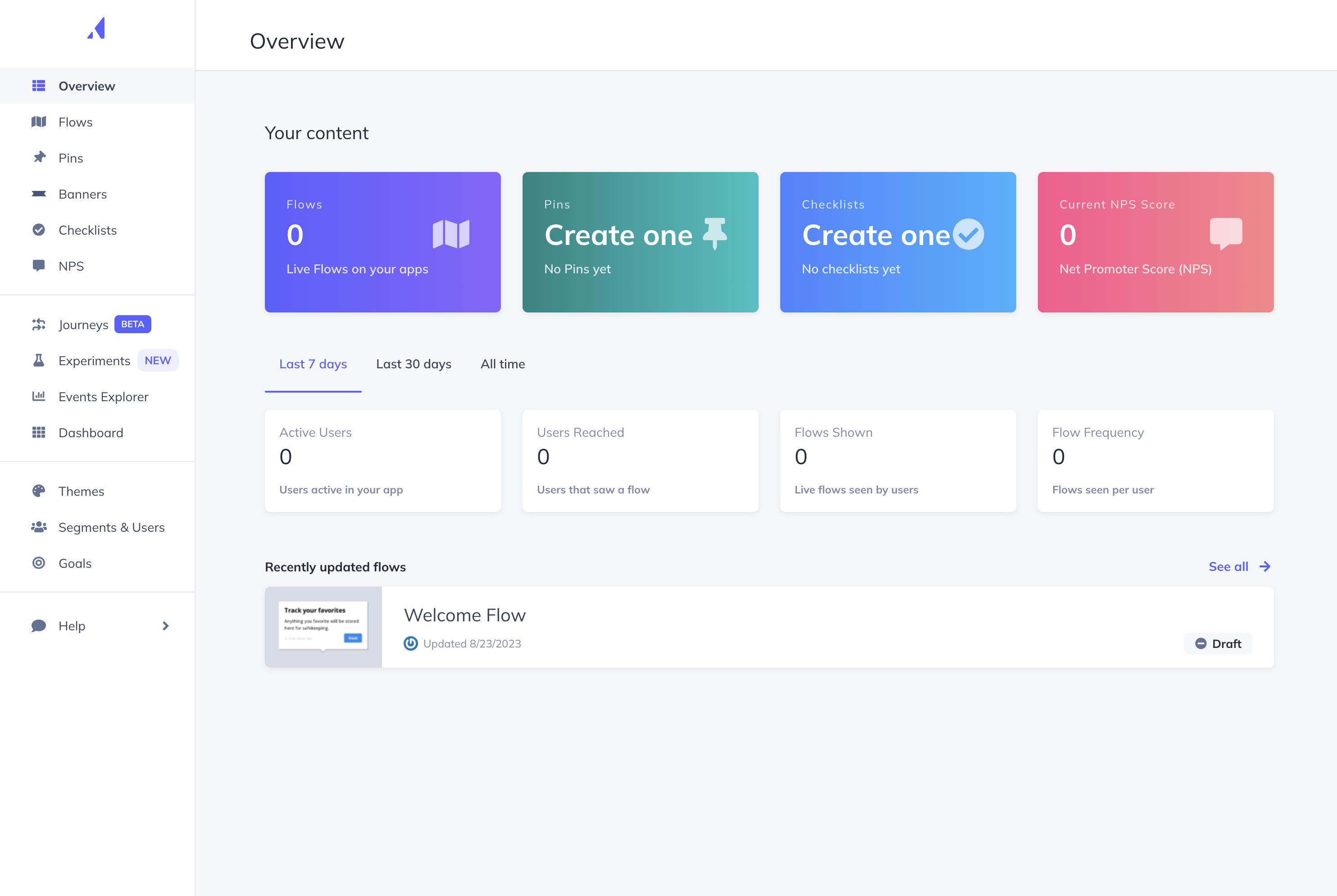
Must have features of user behavior analysis tools
User behavior analytics tools are critical for improving product performance by providing an overview of user interactions and influencing strategic decisions. Here’s what to consider before opting for one:
- Event tracking – so you can track user behavior and activity.
- Goal-based tracking for keeping track of how users make progress toward a goal and identifying bottlenecks.
- User journey tracking and mapping – so you can monitor user engagement across different touch points of the customer journey.
- Behavioral heat maps for visualizing user interactions with heat maps that highlight popular and underutilized UI areas (i.e. feature heat maps).
- Segmentation based on in-app behavior, usage patterns, feedback, and personas — to create personalized, well-timed messages.
- Features to create automated in-app experiences, such as interactive in-app messages and announcements based on specific user actions that offer timely guidance.
Appcues features for user behavior analysis
Behavioral analytics plays a crucial role in improving feature adoption and product usage. It can also help you understand customer sentiment and take proactive steps to retain users.
As a robust user onboarding platform, Appcues offers several tools to help you monitor and analyze user behavior. Let’s take a closer look:
- With the click-to-track feature, you can create and track events (user actions) in a few clicks. Then, you can head to Events Explorer to monitor how many times an event is triggered, unique users who triggered the event, and other data. It can help you understand how users interact with different in-app elements and features.
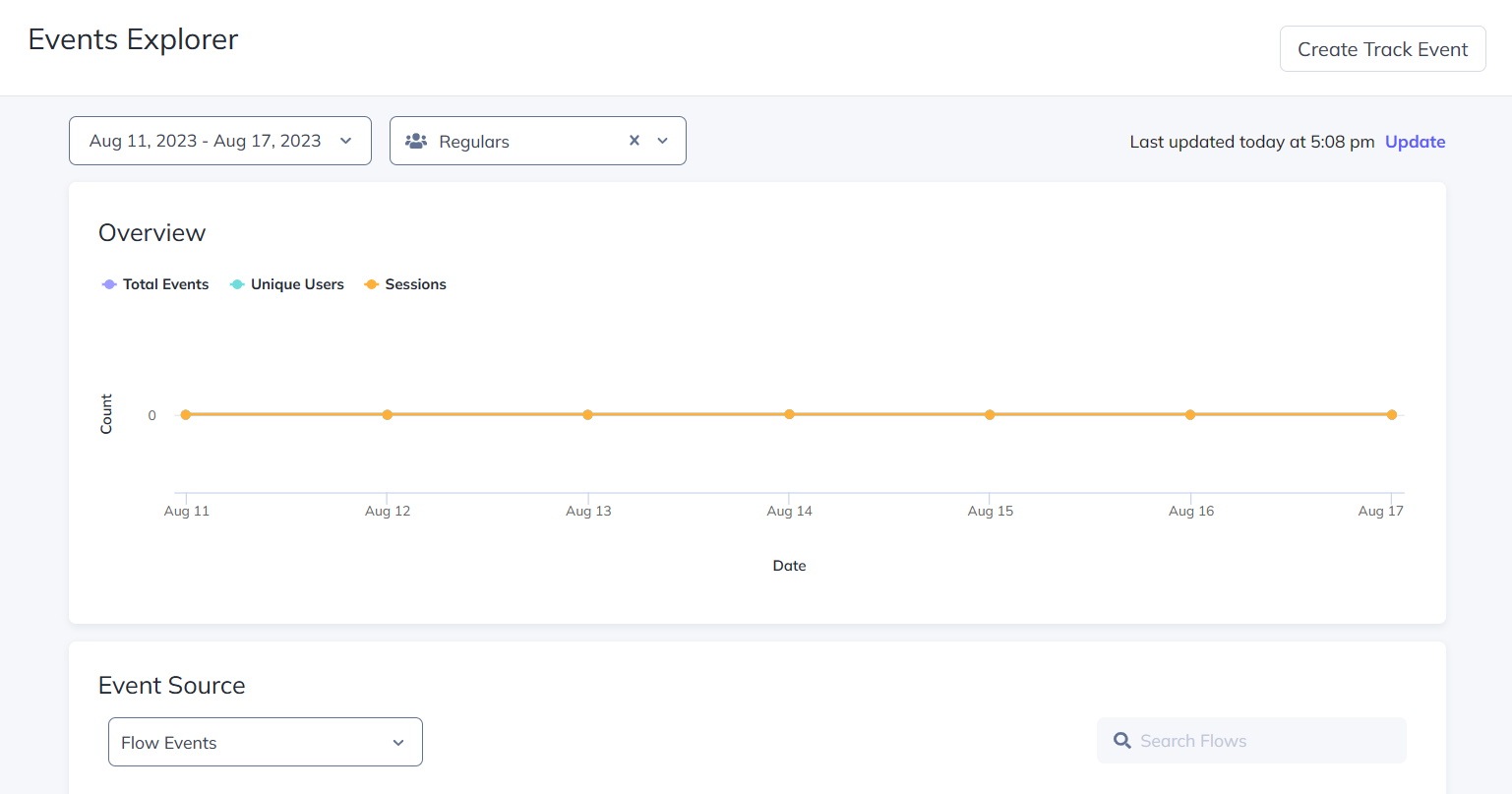
- You can use Flow Performance Metrics to monitor how users interact with different in-app experiences. You can even track the performance of individual flows and each step within a flow to identify potential risk factors for churn.
- You can track engagement with other Appcues experiences, such as checklists, banners, and pins. It can help you identify points of friction within the user journey.
- You can create custom user segments to filter events and flow analysis data. It can provide you with a deeper understanding of how different groups take a specific action or respond to an in-app experience.
Appcues’s event tracking
Collecting and tracking event data is one of the crucial aspects of improving user onboarding and product adoption. It can help you monitor user behavior and understand how different users move within your product.
When it comes to event tracking tools, Appcues offers a few useful features:
- Click-to-track allows you to set up events and track user actions in a few simple clicks. It gives you a clear idea of how users navigate your product and interact with different in-app elements and features.
- Events Explorer helps you visualize event data in the form of easy-to-understand charts. You can filter the results for specific date ranges to monitor event completion over time. Similarly, you can filter the data from different user segments for a better understanding of how different groups behave.

Appcues’s feature tags
Feature tagging plays a crucial role in helping you track user engagement and product usage. It gives you deeper insight into how and where users spend time within your product. Appcues facilitates feature tagging by letting you define and track in-app events.
Here’s how you can leverage feature tagging with Appcues:
- Use the “Track Event” option in Appcues Builder to define an event related to a specific UI element.
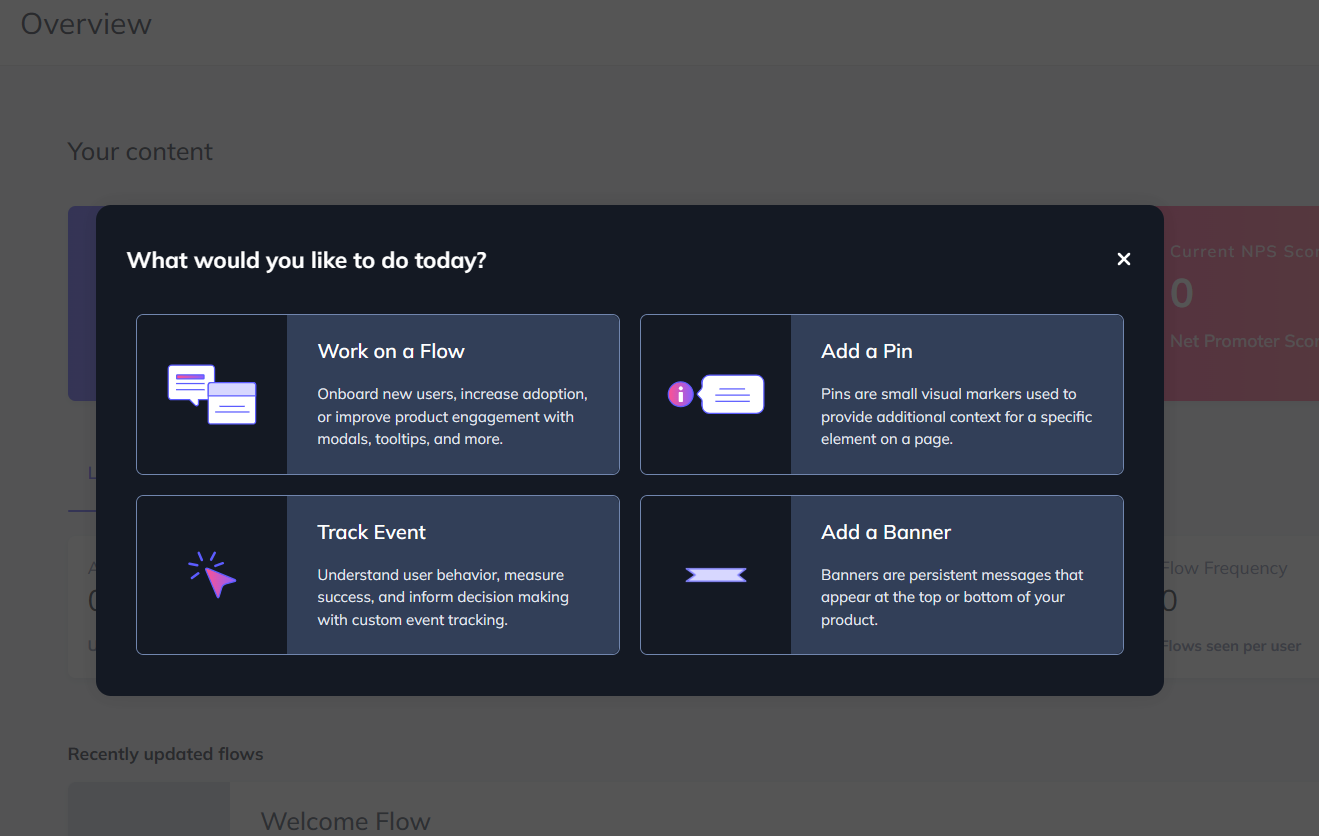
- You can tag up to 10 events on the Essentials plan. If you need more, you’ll need the Growth plan, starting at $879/mo paid annually.
- Use these events to target and trigger personalized Appcues Flows.
- Define custom goals using events to measure how in-app experiences are impacting product usage.
- Use Events Explorer to monitor and visualize data related to individual UI elements.
It’s worth pointing out that the element detection algorithm on Appcues might struggle to identify precise features. If you want to create a more detailed user journey, an alternative like Userpilot would be a better fit.
Appcues’s user journey mapping
Appcues may not be the go-to platform for visualizing and mapping user journeys. You can’t create user journey maps with the tool. However, Appcues offers a few useful features that come in handy for journey mapping.
These include:
- User segmentation
- Click-to-track events
- Event data analysis and visualization
- Powerful integrations with other analytics tools
For instance, you can use Appcues to set up events that track how trial users navigate your product. It can help you identify features that strike a chord with them and points of friction that drive them away. That, in turn, can inform the user journey mapping process.
Appcues’s user segmentation analysis
Appcues lets you group your user base into different segments based on behavior patterns, actions, and demographics. The primary use of these segments is to trigger hyper-personalized onboarding journeys, in-app tutorials, announcements, etc.
However, you can also use segmentation on Appcues to better understand your audience. Here’s how you can do that:
- Select Segments & Users from the left sidebar on your Appcues Studio dashboard. You’ll find four predefined segments: Champions, Regulars, Beginners, and Explorers. You can click on each segment to check the number of users it includes and the flows using it.
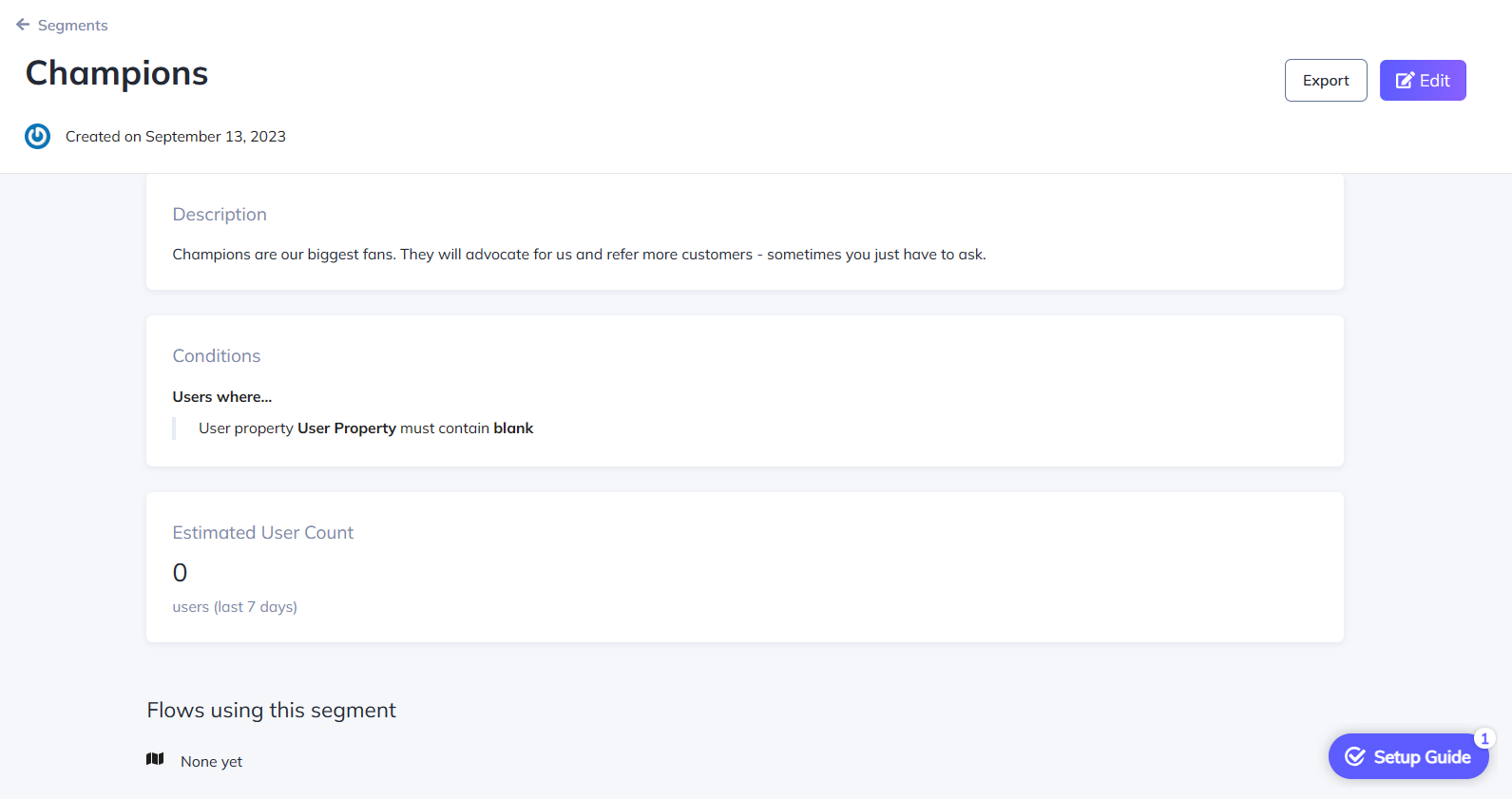
- If you find the pre-defined segments restrictive, you can select Create Segment to build custom segments. You can group users based on events, pre-existing segments, demographics, and engagement with existing in-app experiences.
- Once you’ve defined your segments, you can use them to filter event data and flow performance metrics. Similarly, you can monitor how each segment engages with other Appcues experiences like checklists and pins.
Keep in mind that Appcues only allows 5 segments on their Essential plan, meaning you will have to upgrade to the next plan if you need more in-depth analysis.
What are the pros and cons of Appcues?
Appcues’s pros
As a first-comer in the no-code product adoption landscape, Appcues offers several valuable features. It’s suitable for mid-market SaaS businesses looking for a simple, easy-to-use tool that enhances user onboarding, retention, and the overall customer experience.
Let’s take a closer look at the benefits of Appcues:
- Intuitive UI and UX: Appcues offers a straightforward interface that’s easy to navigate and use. Users with non-technical backgrounds can design captivating in-app flows and onboarding journeys with its simple drag-and-drop builder. You can tailor user journeys with various UI patterns, from modals and hotspots to tooltips, slideouts, and banners.
- Simple setup: You can get started with Appcues in minutes by adding the SDK to your app’s source code or integrating Appcues with Segment or Google Tag Manager. Then, add a Chrome extension to launch the Appcues Builder in a few quick clicks and start creating in-app flows.
- Feedback options: Create Net Promoter Score (NPS) surveys to collect actionable user feedback. You can even check and analyze NPS analytics on your Appcues dashboard.
- Mobile onboarding: Besides web apps, you can use Appcues to create end-to-end experiences for mobile apps. It supports various mobile environments, including Native Android, Native iOS, React Native, Flutter, and Iconic.
- Extensive integrations: Appcues integrates with 20+ email automation, CRM, and analytics tools, including Heap, Zapier, HubSpot, Google Analytics, and Google Tag Manager. Many of these include two-way integrations.
Appcues’s cons
Appcues comes with a ton of useful features you’d expect from a leading product adoption platform, but it does have a few shortcomings.
Let’s look at a few drawbacks of Appcues:
- Poor element detection: The Appcues algorithm occasionally struggles to detect in-app elements, unlike some of its competitors like Userpilot. It’s particularly limiting when you want to add tooltips to individual options in a dropdown menu.
- Limited customization capabilities: While Appcues lets you customize pre-designed templates, you’re limited to basic options like font style, size, color, and padding. Advanced customization requires working with CSS code, which can be challenging for non-technical teams.
- Basic analytics: Appcues provides insights into product usage and customer behavior. However, you can’t access in-depth analytics without connecting to a third-party tool like Amplitude or Google Analytics.
- Limited survey options: Appcues lacks variety in feedback collection and survey options and doesn’t offer integrations with other platforms like Google Forms and Typeform. You can only build NPS surveys. This is in contrast to some of its competitors, like Userpilot, which offers an extensive library of customizable survey templates.
- Higher pricing: Starting at $249 per month, the Appcues Essential tier has several constraints, such as limited UI patterns and no custom CSS support. Moreover, localization support is only available in the Enterprise tier. If your app is multilingual, you’ll have to shell out a ton of money to make the most of Appcues.
- No live chat: While Appcues offers educational resources and a help center (Help Docs), customer support is limited to email and phone.
What do users say about Appcues?
Appcues is a favorite among users, with a 4.8 (out of 5) rating on Capterra and a 4.6 (out of 5) rating on G2. Most users find the platform easy to set up and use and praise its broad spectrum of integrations.
Let’s take a look at all the good things customers say about Appcues:
“Versatile tool for tooltips and in-app guides”
I like how easy it is to pin things in the product and lead customers down a journey. Set up was pretty simple and the integrations they have with Hubspot and Amplitude enable my team for effectively targeting our users and giving them the right messages. I’m a fan of the segmentation. – Sean W., Growth Product Marketing Manager (Mid-market)
Despite stellar ratings, some users have complained about Appcues’ suitability for single-page apps and API documentation. There have also been negative remarks about usability and customer support.
Let’s take a closer look:
“Good In-App Messaging With Some Obvious Product Gaps”
- Can’t invalidate NPS responses.
- NPS Score not available in Heap integration.
- Can’t see survey results in the app
- Makes you pay for localization
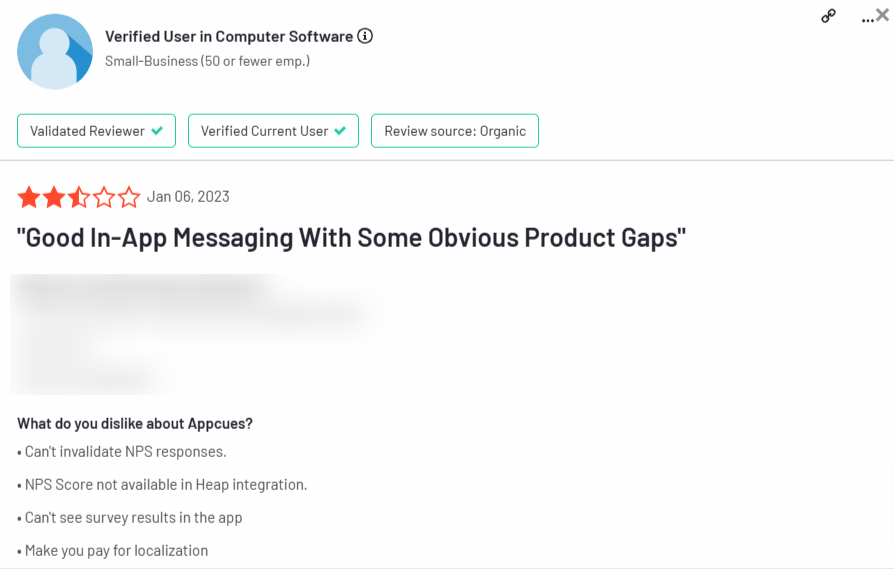
Appcues’s pricing
Pricing for Appcues starts at $249 per month, with the platform offering three distinct tiers – Essentials, Growth, and Enterprise.
The total cost can vary depending on the number of monthly active users (MAU). For instance, the Essential plan starts at $249 per month for 2500 MAU but jumps to $299 for 5000 MAU.
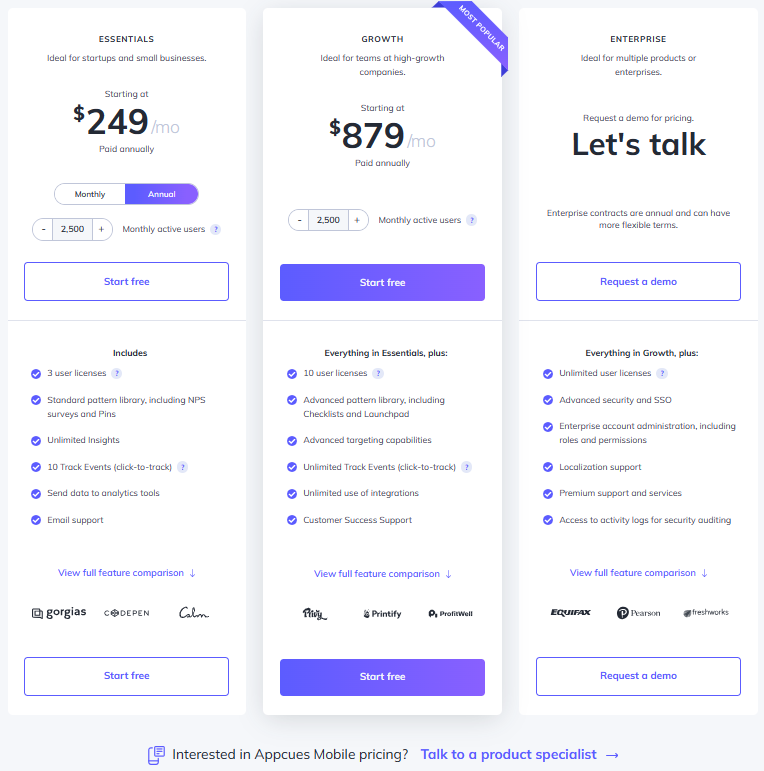
Here’s a detailed glimpse of the different pricing tiers:
- Essentials: It’s the basic tier that starts at $249 per month. It includes 3 user licenses and lets you add up to 5 audience segments. Some UI patterns, such as checklists, launchpads, and custom CSS support, aren’t available. Customer support is only available through email.
- Growth: This tier starts at $849 per month (for 2500 monthly active users) and includes 10 user licenses. You can target unlimited audience segments and use the full spectrum of UI patterns. Additionally, you can access the Premium Integrations package, which includes integrations with Slack, Salesforce, Marketo, and Zendesk.
- Enterprise: This is the most feature-packed tier and includes robust security controls like role-based access and activity logs. It’s also the only tier that comes with multi-account and localization support. Besides email and phone support, you also get a dedicated Customer Success Manager and Technical Implementation Manager. Pricing is available on request.
All three plans come with a 14-day free trial, where you can test unlimited flows and track up to 5 events. You can extend the trial by another 14 days by installing the Appcues SDK in your app. Additionally, you don’t need a credit card to sign up for the free trial.
Keep in mind that the above pricing plans are applicable to web apps. Pricing for Appcues Mobile is available on request.
It’s also worth noting that Appcues is pricier than some of the other product adoption tools available in the market, including Userpilot. For instance, Userpilot’s basic tier (Starter) lets you add up to 10 audience segments and includes the complete set of UI patterns.
3 Reasons why you might need a Appcues alternative
Are you wondering if Appcues is the right fit for your user onboarding needs or if you should check out other options?
Here are a few reasons why using an Appcues alternative makes sense:
- You want more customizability. Customization options on Appcues are limited to color, size, and style. Advanced customization will require you to work with CSS code. It can be a roadblock when your team members lack technical expertise, leaving you dependent on developers.
- You’re on a budget. With Appcues, you’ll have to pay more to access advanced features like custom CSS, localization or even simple checklists. If you’re a startup or small business with a limited budget, you might benefit from using a tool like Userpilot that offers more value for money.
- You want to collect detailed customer feedback. Appcues offers limited functionality in terms of surveys. If you want to explore other survey and feedback collection formats apart from NPS, Appcues may not be an ideal choice.
Userpilot – A better alternative for user behavior analysis
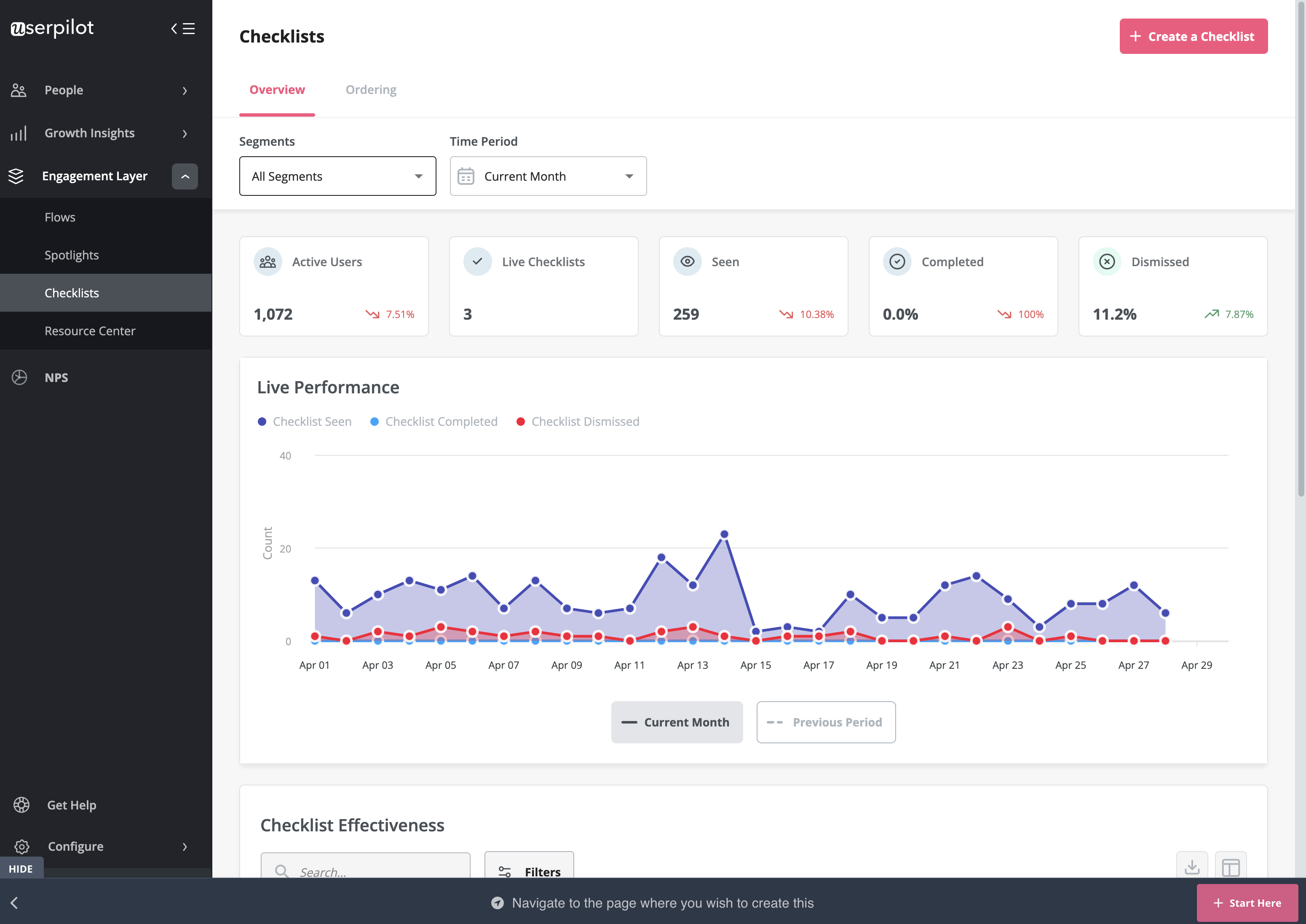 Behavioral analytics make it possible to monitor user activity, group data into cohorts, and extract relevant metrics/insights. Userpilot lets you tag features to see how users interact with them, compare goals by cohort, and create trend reports that track behavioral patterns over time.
Behavioral analytics make it possible to monitor user activity, group data into cohorts, and extract relevant metrics/insights. Userpilot lets you tag features to see how users interact with them, compare goals by cohort, and create trend reports that track behavioral patterns over time.
Here are some Userpilot features you can use for user behavior tracking:
- No-Code Feature Tagging: Userpilot’s click-to-track feature tagger lets you mark features, buttons, and elements with the Chrome extension. You’ll be able to track user interactions such as clicks, hovers, or inputs to get an accurate behavioral view for specific features.

- Funnel Reports: Funnel reports show you the total number of users that enter a funnel and the percentage of users that complete each step. This can help you track behavioral paths and see which stages most users get stuck on.
- Trends Reports: Generating trends reports will help you visualize the occurrence of key events over time and break down these analytics by device, browser, operating system, country, signup date, or even individual user IDs and email addresses to see granular behavioral analytics.
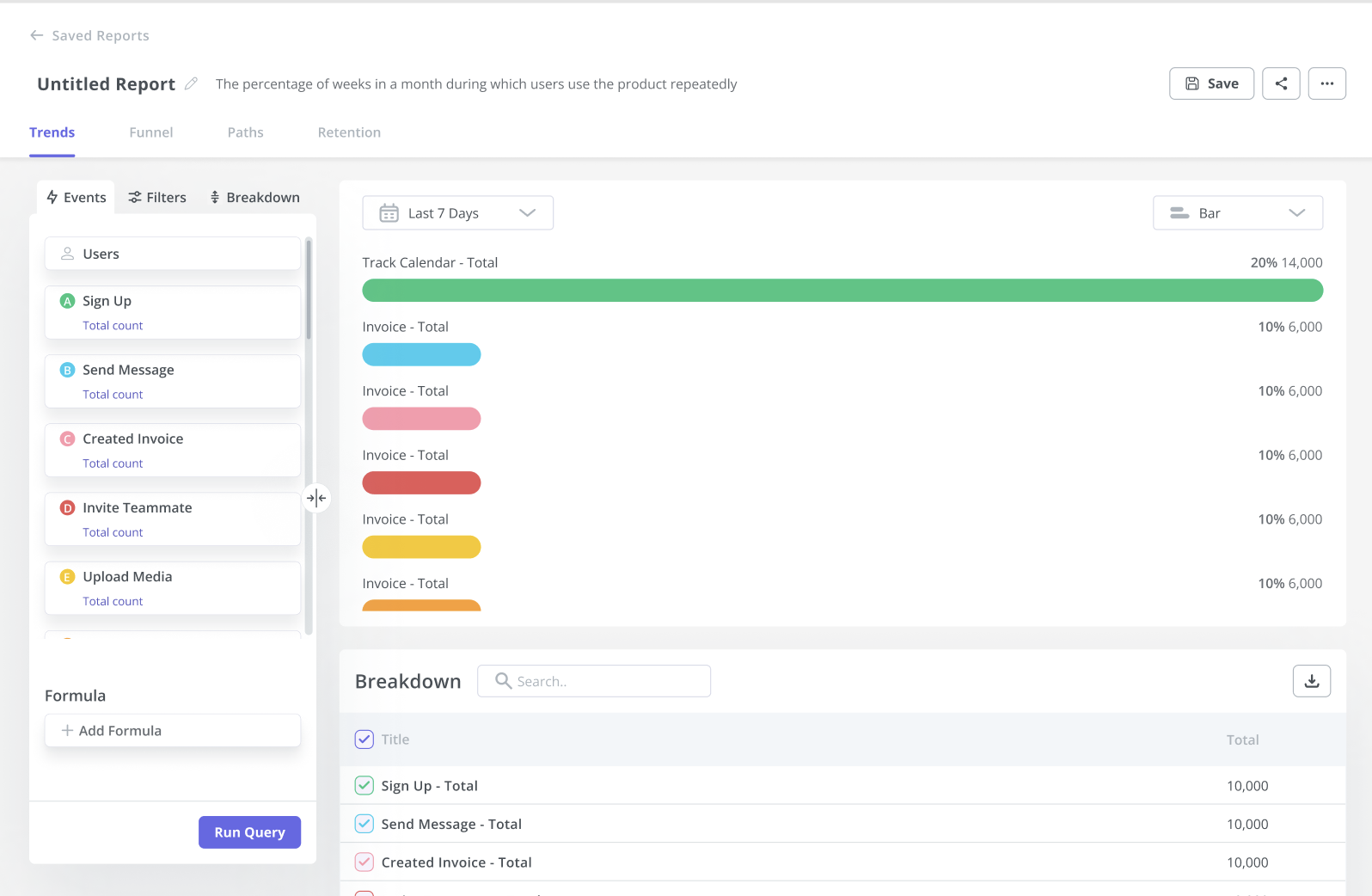
Userpilot’s event tracking
Event tracking is essential for tracking feature usage, progress towards product goals, and extracting actionable insights. Userpilot lets you create event tags without writing any code, view all your goals from a single dashboard, and sync event data to your integrations.
Here’s how you can use Userpilot as an event-tracking tool:
- No-code tagging: Userpilot’s no-code tagging capabilities let you set up event tracking for buttons, features, and elements. You can track clicks, hovers, or user inputs. You’ll also be able to group multiple events as a custom event to give you more accurate insights.

- Event goals: The Goals dashboard will let you track how many users have performed a desired action. You can also track users who have completed a specific event and see how that impacts other aspects of their journey down the line, such as feature usage or upsell events.

- Third-party integrations: Userpilot integrates with dedicated analytics tools like Amplitude, Mixpanel, Heap, and more. This lets you seamlessly stream event data to other tools in your tech stack and get a clearer view of key events across the entire user base.
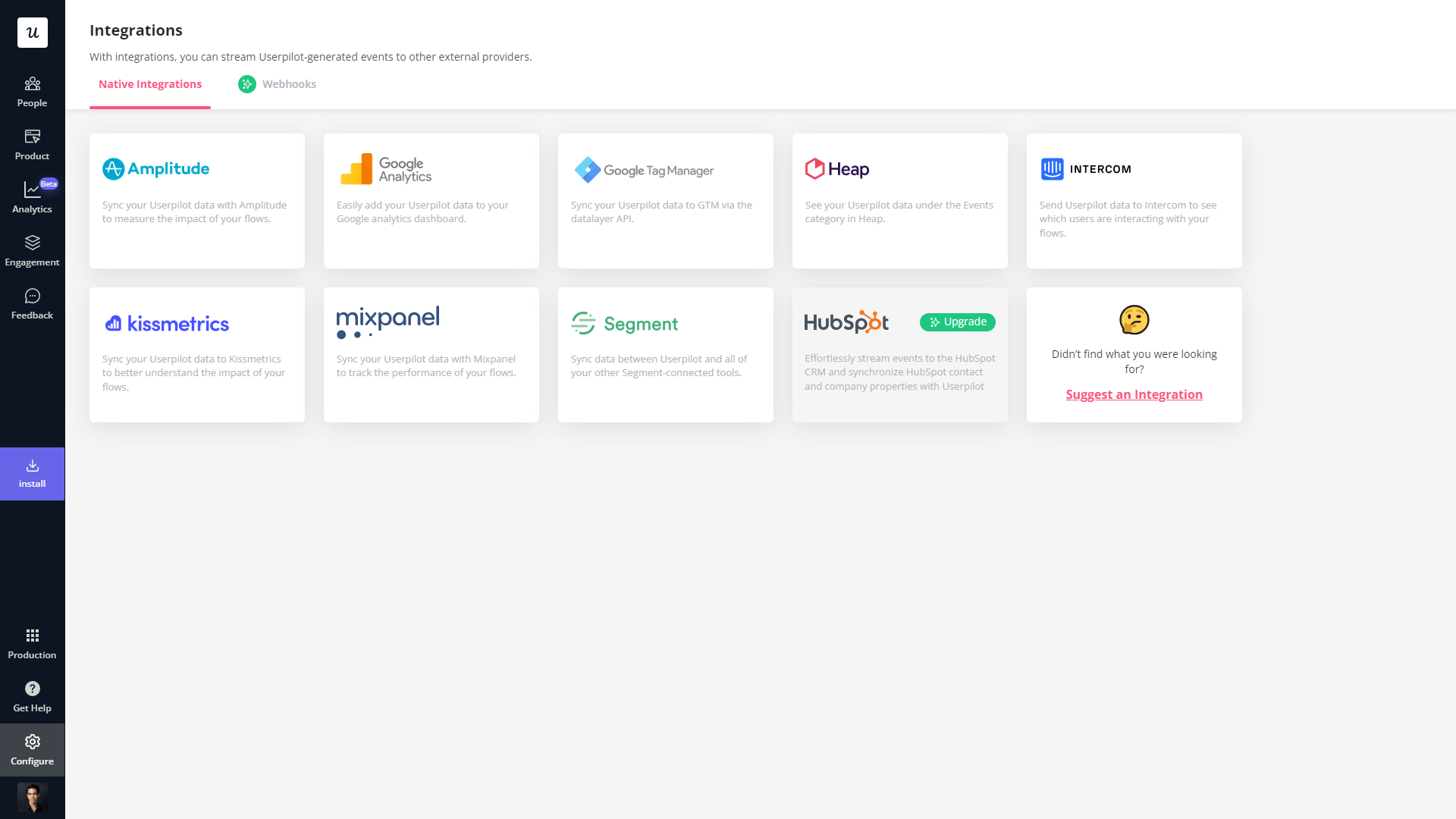
Userpilot’s feature tags
Tracking feature adoption is essential to identify under-utilized features and push users toward discovering them. Userpilot lets you tag features without writing any code, track adoption through engagement analytics, and visualize feature usage with heatmaps.
Here’s how you can use Userpilot to conduct feature audits and drive feature adoption:
- No-code tagging: Userpilot’s no-code feature tagger lets you add tags through the Chrome extension’s visual builder. You’ll also be able to select whether the tag should track clicks, hovers, or text inputs from users to get contextual data that reflects actual feature usage.
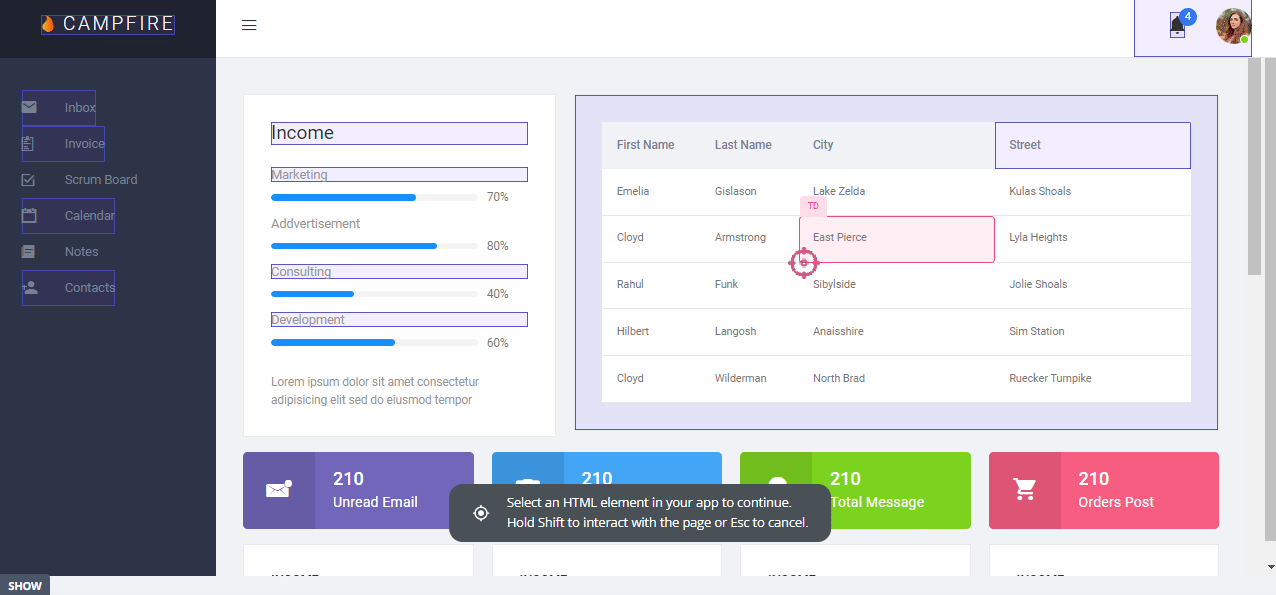
- Feature tags: The advanced feature analytics of Userpilot lets you track feature performance trends, see the top 20 features across your user base, and see granular data for individual features. You’ll also be able to filter your data by segment, company, or time period.
- Usage heatmaps: Userpilot heatmaps show you the features/elements with the most interactions. Heatmaps can be generated on the Features & Events dashboard by clicking on a tagged feature, editing it in the builder, and then clicking the heatmap icon on the bottom toolbar.
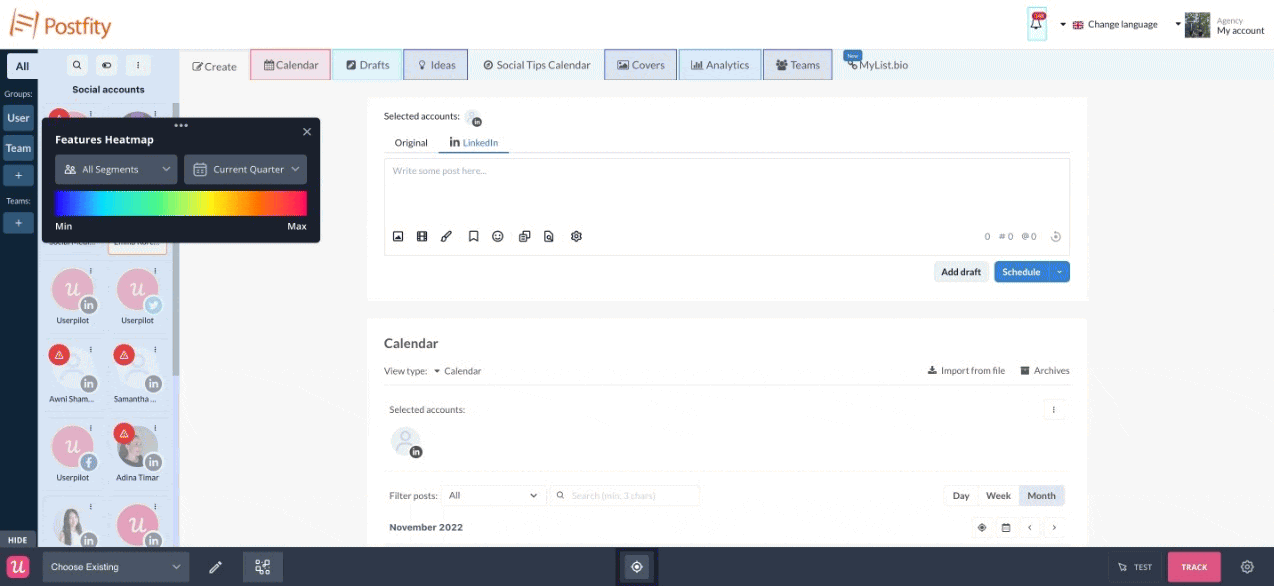
Userpilot’s user journey mapping
User journey mapping helps you visualize all the interactions between users and your product as they try to achieve a particular goal. Userpilot’s detailed user analytics and funnel/trend reports help you track customers as they progress through different stages of their journey.
Here are the Userpilot features you can use for user journey mapping:
- User analytics: The Users dashboard provides detailed analytics of your entire customer base. You’ll be able to sort by segment, company, or time period and add multiple filters to help you narrow results. You can also perform bulk actions and export user data in a CSV format.
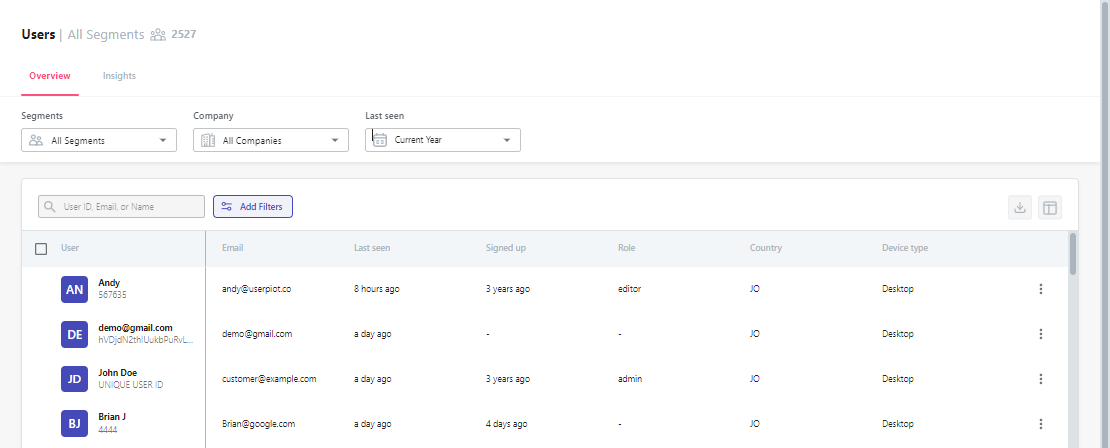
- Funnel reports: These reports help you visualize the user journey map by showing which stage, page, or action most users get stuck on. You’ll also be able to view breakdowns so you can see how the user journey changes depending on which OS, browser, or device type a user is on.
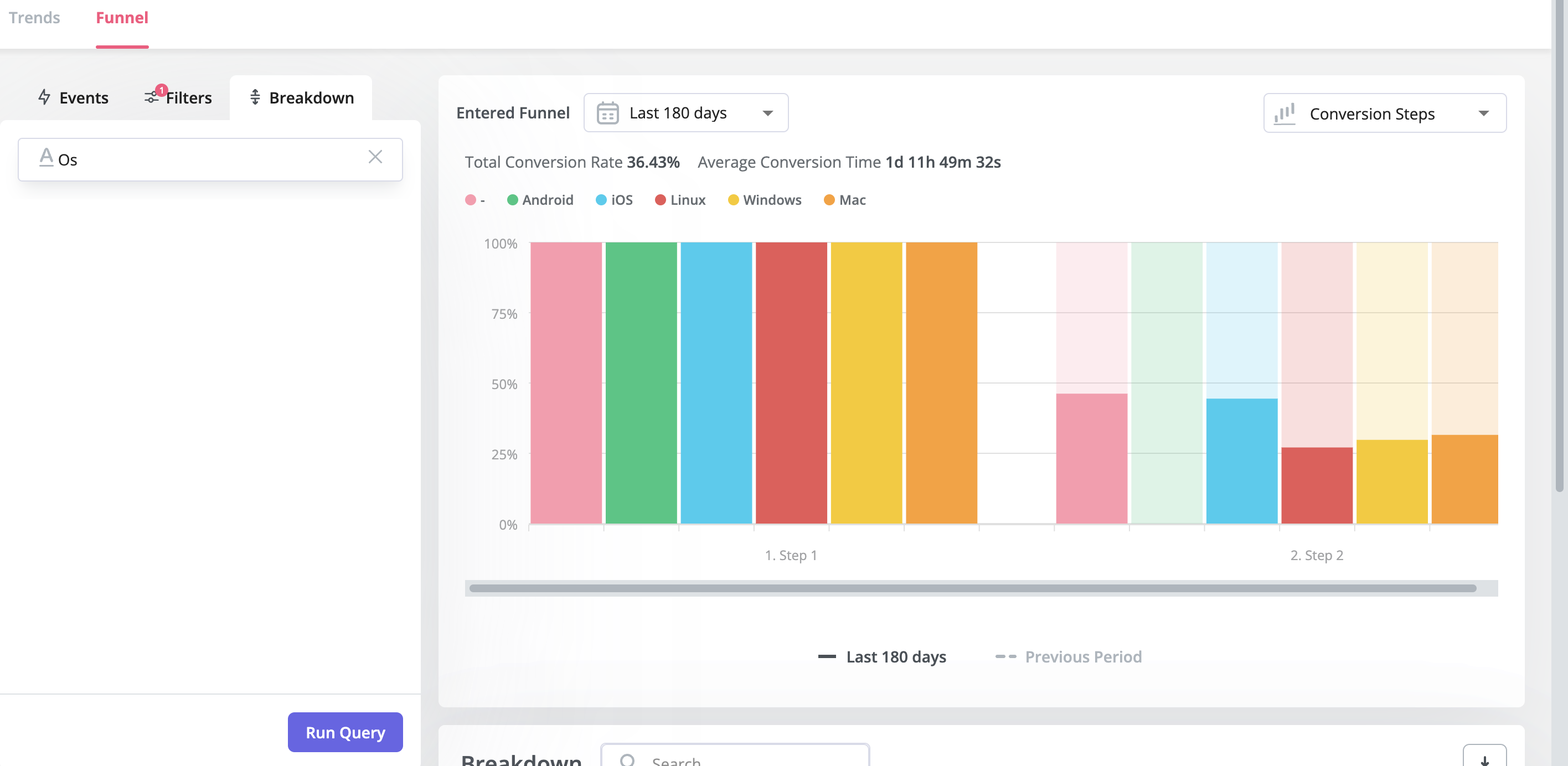
- Trend reports: Userpilot’s trend reports offer behavioral insights such as how often users perform a specific action, the number of unique users who take that action, and where in the user journey these actions occur. You can also create custom metrics and build your own charts.

Userpilot’s user segmentation analysis
User segmentation is a key part of building a contextual onboarding experience for new customers. Userpilot lets you segment your customers when they meet specific conditions, filter through analytics using user attributes, and trigger flows for users in different segments.
Here are some of Userpilot’s customer segmentation capabilities:
- Conditional Segments: Userpilot lets you build segments for users who match conditions on what device/browser/OS they’re using, which country they live in, what their NPS score is, and any custom events they’ve performed. You can then use these segments as filters/triggers.

- Analytics Filters: The product analytics and user insights dashboards on Userpilot can be set to only show data from certain user segments or companies. This makes it possible to identify actionable insights from specific user cohorts and benchmark performance between segments.
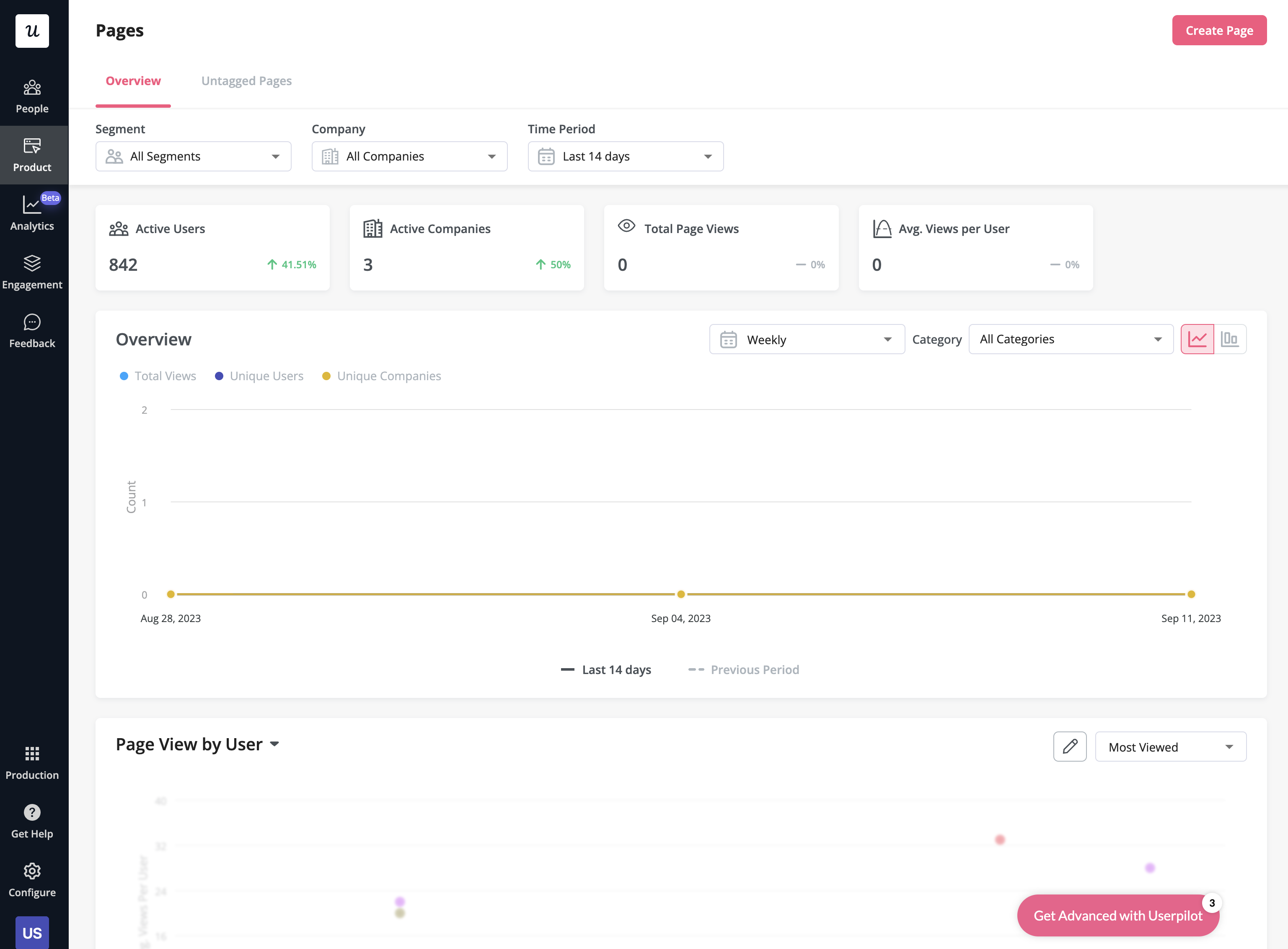
- Flow Triggers: Userpilot audience settings make it possible to target in-app flows to certain user segments or only show flows to users who meet specific conditions. You could also add event-based or page-specific triggers to show relevant flows with contextual timing.
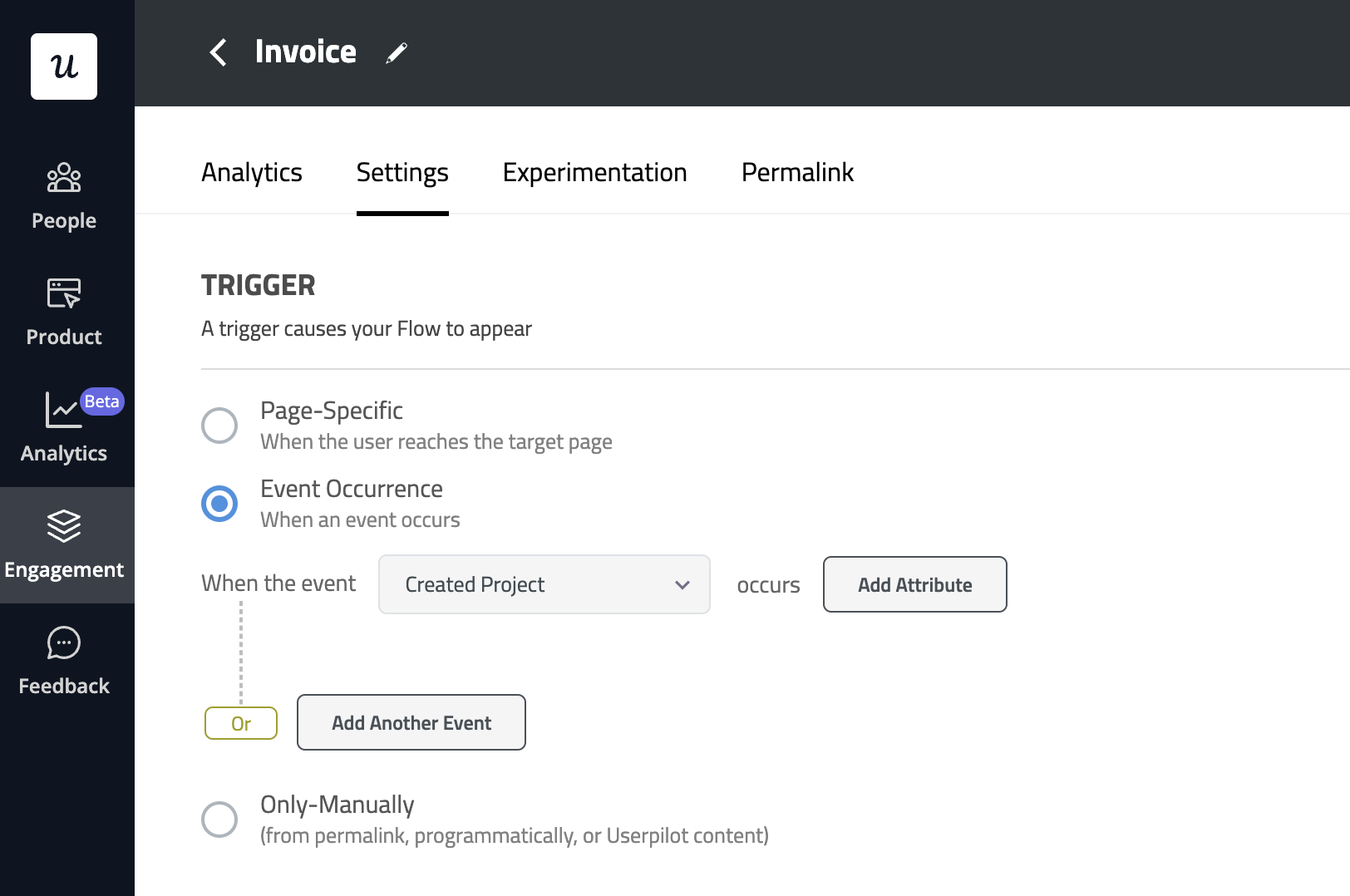
What are the pros and cons of Userpilot?
Userpilot pros
As a full-suite digital adoption platform, Userpilot has all the features you need to onboard users, track analytics, and gather feedback from customers without writing a single line of code. Here are a few pros of using Userpilot as your product growth solution:
- No-code builder: Userpilot’s Chrome extension lets you build flows, add UI elements, and tag features without writing a single line of code.
- UI patterns: There are plenty of UI patterns to choose from when using Userpilot, such as hotspots, tooltips, banners, slideouts, modals, and more!
- Startup-friendly: Userpilot’s entry-level plan gives you access to all available UI patterns so you can hit the ground running.
- Walkthroughs and flows: Build engaging interactive walkthroughs and personalized onboarding flows that target specific segments of your user base.
- Self-service support: Build an in-app resource center to help users solve problems, customize its appearance to align it with your brand, and insert various types of content (videos, flows, or chatbots) to keep your customers satisfied.
- A/B testing: Userpilot’s built-in A/B testing capabilities will help you split-test flows, iterate on the best-performing variants, and continually optimize based on user behavior.
- Feedback collection: Userpilot has built-in NPS surveys with its own unified analytics dashboard and response tagging to help you retarget users. There are other survey types to choose from and you can even create your own custom survey.
- Survey templates: There are 14 survey templates to choose from so you can gather feedback on specific features or run customer satisfaction benchmarking surveys like CSAT and CES.
- Advanced analytics: Userpilot lets you analyze product usage data, monitor engagement on all in-app flows, and use the data to create user segments that are based on behaviors instead of demographics.
- Event tracking: Userpilot’s no-code event tracking lets you tag UI interactions (hovers, clicks, or form fills) and group them into a custom event that reflects feature usage.
- Third-party integrations: Userpilot has built-in integrations with tools like Amplitude, Mixpanel, Kissmetrics, Segment, Heap, HubSpot, Intercom, Google Analytics, and Google Tag Manager so you can share data between all the solutions in your tech stack.
Userpilot’s cons
Of course, no tool is perfect and there are a few cons to consider before choosing Userpilot as your user onboarding or product growth solution:
- Employee onboarding: Currently, Userpilot only supports in-app customer onboarding.
- Mobile apps: Userpilot doesn’t have any mobile compatibility which could make it difficult for developers with cross-platform applications to create a consistent user experience for both versions of their product.
- Freemium plan: There’s no freemium Userpilot plan so those bootstrapping their startup and need sub-$100 solutions should consider more affordable onboarding platforms like UserGuiding or Product Fruits.
What do users say about Userpilot?
Most users laud Userpilot for its versatile feature set, ease of use, and responsive support team:
I recently had the pleasure of using Userpilot, and I must say it exceeded all my expectations. As a product manager, I’m always on the lookout for tools that can enhance user onboarding and improve overall user experience. Userpilot not only delivered on these fronts but also went above and beyond with its impressive new features, unparalleled ease of use, and truly exceptional customer support.
What truly sets Userpilot apart is its outstanding customer support. Throughout my journey with Userpilot, the support team has been responsive, knowledgeable, and genuinely dedicated to helping me succeed. Whenever I had a question or encountered an issue, their support team was always there to assist promptly, going above and beyond to ensure my concerns were addressed effectively.

Source: G2.
Of course, other users are also kind enough to share constructive criticism regarding specific features like event tracking filters:
“The filtration while analyzing specific events is a little confusing. Understanding of custom properties and data management configuration could have been more organised.”

Source: G2.
Userpilot’s pricing
Userpilot’s transparent pricing ranges from $249/month on the entry-level end to an Enterprise tier for larger companies.
Furthermore, Userpilot’s entry-level plan includes access to all UI patterns and should include everything that most mid-market SaaS businesses need to get started.

Userpilot has three paid plans to choose from:
- Starter: The entry-level Starter plan starts at $249/month and includes features like segmentation, product analytics, reporting, user engagement, user feedback, and customization.
- Growth: The Growth plan starts at $499/month and includes features like resource centers, advanced event-based triggers, unlimited feature tagging, AI-powered content localization, EU hosting options, and a dedicated customer success manager.
- Enterprise: The Enterprise plan uses custom pricing and includes all the features from Starter + Growth plus custom roles/permissions, access to premium integrations, priority support, custom contract, SLA, SAML SSO, activity logs, security audit and compliance (SOC 2/GDPR).
Conclusion
There you have it.
It should be easier now to make an informed decision whether Appcues is your go-to option for User behavior analysis. Ultimately, the best choice will depend on your product and current needs.
If you’re looking for a better alternative to Appcues for User behavior analysis, book a Userpilot demo today to experience firsthand how it can enhance your user experience and drive product growth!
![]()
Looking for a Better Alternative for User Behavior Analysis? Try Userpilot

